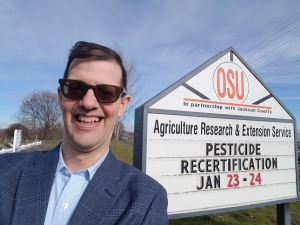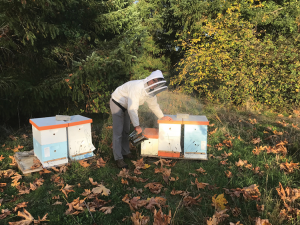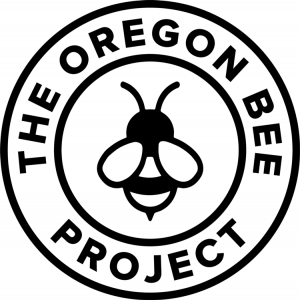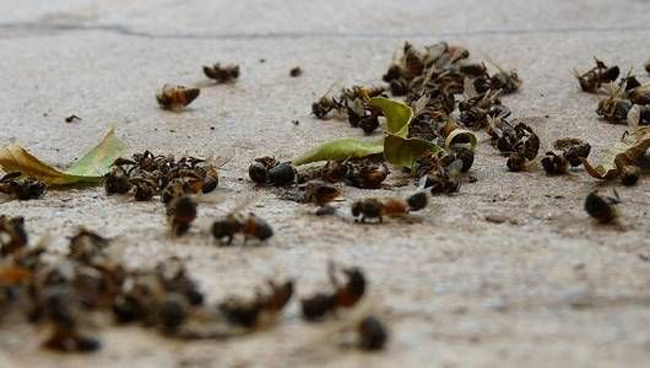By Dewey Caron
In Wilsonville, Oregon there was a massive kill of bumble bees in the parking lot of a Target store on a Sunday morning in mid-June, 2013.
Over 50,000+ bumble bees, mainly of one species (Bombus vosnesenskii), foraging that morning on 55 flowering European linden trees (Tilia cordata) shading the parking lot contacted the neonicotinoid dinotefuran (product name=Safari), applied to kill the aphids feeding on those same trees.
The sap-feeding insects excrete the majority of the plant sap they suck up to get rid of the excess sugar they take in. Beekeepers know their exudate as honey dew. Customers of the store know it as the “sticky stuff” that smears their windshields.
 Oregon Department of Agriculture and Oregon State University experts were called, along with Rich Hatfield, a bumble bee insect conservation expert of Portland-based Xerces Society, to assess the damage (see website https://xerces.org/the-wilsonville-bee-kill/ for links to initial and a number of subsequent reports on the kill; I discuss the incident in previous Bee Culture, June 25, 2013).
Oregon Department of Agriculture and Oregon State University experts were called, along with Rich Hatfield, a bumble bee insect conservation expert of Portland-based Xerces Society, to assess the damage (see website https://xerces.org/the-wilsonville-bee-kill/ for links to initial and a number of subsequent reports on the kill; I discuss the incident in previous Bee Culture, June 25, 2013).
The bumble bees, from an estimated 300 bumble bee nests, were likely flying to the parking lot from an immediately adjacent farm that was in the third year of red clover seed production. Such fields have elevated numbers of voles, whose tunnels provide excellent nesting habitat for bumble bees. Any other parking lot, at any other site, and the killing of such large numbers of bumble bees would not likely have occurred.
With their own investigation, the Oregon Department of Agriculture found the pesticide in dead bees and subsequently restricted the use of four neonicotinoids, dinotefuran, imidachlorprid, clothianidin and thiomethoxan for use on linden trees. The spray applicators were fined – less than $1000 each.
So what else happened?
This “accident” set in motion a number of diverse activities. There was point of sale picketing in protest of neonicotinoids and general public “protest” activities meant to “speak” on behalf of the bumble bees and raise awareness of pesticide dangers. More recently introduction of the OR Pollinator Protection Act, an effort similar to one passed in MD, to limit the sale of neonicotinoids to individuals not trained in safe use of pesticides was proposed as legislation. Unfortunately, this bill did not get out of committee during the most recent session.
More substantively, the Oregon Legislature established an eight member Pollinator Task Force. By the end of 2014, this Task Force sent a couple of consensus opinions to the Legislature that called for expansion of pollinator outreach and education, and support for new research on pollinator health. Note: several other recommendations did not result in a consensus but were included in the report: read task force report at: https://olis.leg.state.or.us/liz/2013I1/Downloads/CommitteeMeetingDocument/41335.
Also in 2014, in Washington, DC, President Obama signed a Presidential Memorandum creating an Interagency Task Force to create a strategy to promote the health of honey bees and other pollinators. https://obamawhitehouse.archives.gov/the-press-office/2014/06/20/presidential-memorandum-creating-federal-strategy-promote-health-honey-b
With this background, the 2015 Oregon Legislative agenda included three(3) bills for Legislative action. The three Oregon House Bills, numbers 3361, 3362, and 2653 were passed based on the Task Force recommendations (summarized below). The full text of HBS 3361, 3362 and 2653 may be accessed at: https://www.oregonlegislature.gov/bills_laws.
- HB 3361: Make available to the public best management practices (BMP) to improve pollinator health for native and managed pollinators in urban, roadside and agricultural areas throughout Oregon.
- HB 3362: Develop educational materials and an outreach and education plan outlining the best practices for industry and the general public in the use of pesticides. Additionally develop a safety plan for pesticide applicators that protects honey, bumble, native bees & other pollinators toward avoiding adverse effects of pesticides on pollinator populations.
- HB 2653: Develop guidelines, educational materials and best practices for beekeeping within urban, residential and rural residential areas, including recommendations for ordinances to mitigate nuisance conflicts.
To provide leadership and focus for the bills passed, the legislature looked to Oregon State University and Oregon Cooperative Extension for implementation. Dr. Andony Melathopoulos, an expert on bee pollination, was hired, after an International search, as Cooperative Extension Pollinator Health Specialist at OSU, at the end of 2016. He specifically was brought on board to focus on improving the health of honey bees and other pollinating bees.
 Andony Melathopoulos brings 15 years of experience to this new position. He came to OSU from a post-doctoral position in pollination ecology at the University of Calgary in Alberta, Canada. He completed an interdisciplinary PhD at Dalhousie University, Halifax, Nova Scotia (2015) and a Master of Pest Management from Simon Fraser University (1999). He was an Honors scholar at Simon Fraser as an undergraduate, doing a pheromone project under Mark Winston. In between, he was a technician in Agri-Food Canada’s Apiculture Research program (2000-2012), Beaverlodge, Alberta. His PhD included studies of bumble and honey bees in lowbush blueberry fields in Atlantic Canada and Maine and his post-doc was of honey and leafcutter bees in canola in the province of Alberta.
Andony Melathopoulos brings 15 years of experience to this new position. He came to OSU from a post-doctoral position in pollination ecology at the University of Calgary in Alberta, Canada. He completed an interdisciplinary PhD at Dalhousie University, Halifax, Nova Scotia (2015) and a Master of Pest Management from Simon Fraser University (1999). He was an Honors scholar at Simon Fraser as an undergraduate, doing a pheromone project under Mark Winston. In between, he was a technician in Agri-Food Canada’s Apiculture Research program (2000-2012), Beaverlodge, Alberta. His PhD included studies of bumble and honey bees in lowbush blueberry fields in Atlantic Canada and Maine and his post-doc was of honey and leafcutter bees in canola in the province of Alberta.
New beekeepers are often not aware of how the Cooperative Extension Service helps beekeepers. About 25 U.S. Universities have Extension Bee specialists, located at their State supported (Land Grant) University or one of the regional research/extension station sites. Most of the 3142 US counties (includes parishes in LA, boroughs in Al + a few cities) have County Extension agents; a number are beekeepers or are sufficiently knowledgeable that they service local beekeeping associations. Few University Bee specialists (exceptions are UC Davis and Penn State) concentrate only on honey bees as their major responsibility.
Dr. Melathopoulos’ extension position at OSU is a bit specific and unusual. The position is part of a $14 million commitment to pollinators authorized by the 2015 Oregon Legislature. Funding also implemented a diagnostic lab under honey bee specialist Ramesh Sagili and operational funding from registration fees for pesticides.
Andony’s specific task is to design, develop and implement a multi-disciplinary Extension program in pollinator health, with a focus on collaboratively developing and disseminating educational materials, such as Best Management Practices (BMP). The overarching aim is to enable stakeholders to adopt practices that will have a positive impact on pollinator health that support Oregon agriculture and environmental sustainability.
Unlike traditional honey bee extension that focuses on beekeepers and growers of pollinator dependent crops, the mandate for OSU Pollinator Health Extension is broad engagement around issues of pollinator health. In part, this broadened scope is the product of the specific issues that arose in Oregon, namely landscape practices impacting native bee populations combined with broad public concern around the plight of pollinators generally. But the mandate of the OSU Pollinator Health program also reflects a widened public focus to include not just honey bee, but native bees, and not just agriculture, but additionally urban land management.
 Another uniqueness of the OSU Pollinator Health program is a close integration with state agencies, such as the Oregon Department of Agriculture and Oregon Department of Forestry. In many states pollinator health plans have become the domain of either the Department of Agriculture or land grant Universities. In Oregon, state-wide pollinator health activities are closely coordinated between OSU and state agencies in the Oregon Bee Project (www.oregonbeeproject.org).
Another uniqueness of the OSU Pollinator Health program is a close integration with state agencies, such as the Oregon Department of Agriculture and Oregon Department of Forestry. In many states pollinator health plans have become the domain of either the Department of Agriculture or land grant Universities. In Oregon, state-wide pollinator health activities are closely coordinated between OSU and state agencies in the Oregon Bee Project (www.oregonbeeproject.org).
The goal of the Oregon Bee Project is to produce an active and engaging set of initiatives that connect beekeepers, land managers, pesticide applicators, native bee enthusiasts, conservationists and gardeners into a coordinated set of activities. “We want to give individuals the tools to keep Oregon pollinator-friendly,” Melathopoulos said. “If we do our job right, protecting pollinators will merge seamlessly with people’s daily life and work.”
As Dr. Melathopoulos explains: “a true measure of [our] activity will be evaluation of change, not merely how many materials are dispensed, how many presentations given or how many reports are generated.” He acknowledged that for the Oregon Bee Project to succeed it has to “produce results; people need to see changes and they need to own the process that drives those changes”.
The strategy for Oregon Bee Project is to highlight and promote land managers and industries that then develop bee-friendly practices such as Flagship Farms or Flagship Industries. In this way, land managers can take ownership and get credit for developing best management practices. Joining in and enthusiastically participating are the Oregon State Beekeepers Association and native bee conservationists. OSU Pollinator Health is also working with the recently developed Oregon Master Beekeepers programs to train new beekeepers from around the state on these practices.
The activity of Andony is to integrate what has occurred in recent years in rapid growth of residential beekeeping. OSU Pollinator Health has worked with the Oregon State Beekeepers Association to develop best management guidelines for reducing nuisances associated with residential beekeeping. The goal is to reduce nuisance residential beekeeping, not through restrictive regulations, but through a robust educational program.
So maybe 50,000 + bumble bees may not have died in vain. They have become a ‘poster child’ of what can happen, and is happening in our surroundings. The Oregon Bee Health initiative, from a mandate from our state legislature, is working with a diverse and engaged clientele to help bumble bees honey bees and conservationists and beekeepers to sustainably insure healthy populations of pollinators.









